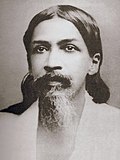Spiritual community in Pondicherry
Not to be confused with Sri Aurobindo Ashram, Rewa.
 The Mother's symbol | |
 Entrance to Sri Aurobindo Ashram | |
 | |
| Formation | 24 November 1926(99 years ago) (1926-11-24) |
|---|---|
| Founder | Sri Aurobindo |
| Type | Spiritual community |
| Legal status | Foundation |
| Purpose | Religious Studies, meditation |
| Headquarters | Pondicherry, India (No Branches) |
| Coordinates | 11°56′12″N79°50′03″E / 11.936708°N 79.834039°E / 11.936708; 79.834039 |
Main organ | Sri Aurobindo Ashram Trust |
| Website | sriaurobindoashram.org |
| Sri Aurobindo |
|---|
 |
Family
|
Speeches and books |
Teachings |
Places |
Communities |
Journals and forums |


The Sri Aurobindo Ashram (French: Ashram de Sri Aurobindo) is a spiritual community (ashram) located in Pondicherry, in the Indian territory of Puducherry. It was founded by Sri Aurobindo after he settled in Pondicherry in 1910. On 24 November 1926 turned over control of the ashram to his collaborator Mirra Alfassa. [1] It houses the samadhi of Sri Aurobindo and Mira Alfassa. [2]

